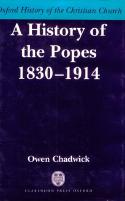 |
A HISTORY OF THE POPES 1830-1914 By Owen Chadwick Oxford University Press, 614 pages, $39.95 |
Book offers a full, nuanced history of the papacy in the 19th century
Reviewed by JOHN W. O’MALLEY
If like many Catholics you like to read about the popes, this is a book for you. If you simply want to know more about the trauma Catholicism suffered after the French Revolution and how it began to overcome it, this is also the book for you. If you just like history and want a good read, this is the book for you. Owen Chadwick, emeritus Regius Professor of Modern History at Cambridge, has here pulled off a tour de force.
He covers four pontificates, beginning with Gregory XVI, “the most hated pope for two centuries,” then moves on to Pius IX and Leo XIII and ends with Pius X. Each of these popes is important, and the names of the last three are familiar to anybody interested in 19th-century Europe. Although they appear often in history books, they rarely get treatment that is comprehensive. That is one of the strengths of the book. Chadwick covers every one of these four popes “in the round,” so that you become aware of the many balls they were trying to juggle at the same time. The full treatment also gives him room for concrete details that bring the stories to life. One of my favorites is the ordinance under Gregory XVI about who might attend the execution of criminals in the Papal State and what medals the papal officers might wear for the occasion.
Of the four popes, Pius IX is the most important and receives the most extensive coverage. Chadwick devotes about 50 pages to Vatican Council I -- the political and ecclesiastical background and then the process of the council itself. He devotes another 50 to Pius as self-imposed and self-proclaimed “Prisoner of the Vatican” after the fall of Rome to Italian troops in 1870. This is all high drama, but so is the earlier part of Pius’s story, which includes his flight in disguise from Rome on the night of Nov. 24, 1848. So is the story of the conclaves, especially the conclave of 1903 that elected Pius X.
Chadwick ranges beyond what his title indicates to provide narratives about the church in the major European countries. With the popes still as the focus, the book turns out to be a full-fledged history of the European setting in which the church had to operate. Understanding Italy is of course crucial for understanding the 19th-century papacy, but France and Germany are also especially important and receive incisive coverage. The sections on Spain, Portugal and Poland are welcome because we tend to hear and read less about them.
In the first half of the book, the other European nation that Chadwick perforce holds up to the reader’s eyes at considerable length is the Papal State itself. Contemporaries considered it the most backward and corrupt political unit on the continent. Chadwick provides plenty of evidence for why that opinion was widespread, but he is fairer, seeing the problems more as a result of incompetence than of craftiness. One thing comes through these pages clearly: Given the political weakness of the Papal State and the aggressiveness of its enemies, there was no way it was going to survive through the 19th century.
Besides being a distinguished historian, Chadwick is an Anglican priest. His earlier books dealt with the Reformation, but in the past two decades he has focused increasingly on the modern papacy, a somewhat strange specialty for somebody with his background. But that very background gives him a critical distance from his subject. These four popes -- at least three of whom, to say the least, had their “dark side” -- could hardly hope for a fairer or more judicious treatment than they receive in these pages. When in 1830 Lord Clarendon declared that the government of the Papal State was a scandal to Europe, a war of words ensued. Chadwick with even hand presents the indignant reply of the pope’s defenders: Who are the English, with their squalid prisons, their public floggings, their justice only for the rich, to set themselves up on such a high moral pedestal?
Chadwick brings to his subject a mastery of the political and ecclesiastical issues of 19th-century Europe, yet the book is eminently accessible to the non-specialist. He writes well. In this instance he needed a more assiduous copyeditor than Oxford University Press provided -- somebody who would have tightened up some sentences and saved him from a few minor (but surprising) mistakes, such as calling St. Peter’s Basilica in Rome a cathedral. But these are mere quibbles. This is an excellent book, and I highly recommend it.
Jesuit Fr. John W. O’Malley teaches at the Weston Jesuit School of Theology in Cambridge, Mass. He is author of The First Jesuits and Trent and All That: Renaming Catholicism in the Early Modern Era.
National Catholic Reporter, March 5, 2004